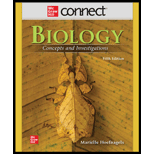
BIOLOGY:CONCEPTS+INVEST.-CONNECT ACCESS
5th Edition
ISBN: 9781260542233
Author: Hoefnagels
Publisher: MCG
expand_more
expand_more
format_list_bulleted
Question
Chapter 17.2, Problem 5MC
Summary Introduction
To analyze:
The type of
Introduction:
A tiny single-celled organism known as a prokaryote lacks a distinct core with a layer and other distinctive organelles. Archaea and microbes are both included in prokaryotes.
Expert Solution & Answer
Want to see the full answer?
Check out a sample textbook solution
Students have asked these similar questions
Please draw in the missing answer, thank you
Please fill in all blank questions, Thank you
please fill in missing parts , thank you
Chapter 17 Solutions
BIOLOGY:CONCEPTS+INVEST.-CONNECT ACCESS
Ch. 17.1 - What are two domains that contain prokaryotes?Ch. 17.1 - Prob. 2MCCh. 17.1 - Prob. 3MCCh. 17.1 - Prob. 4MCCh. 17.2 - Prob. 1MCCh. 17.2 - Prob. 2MCCh. 17.2 - What does the Gram stain reveal about a cell?Ch. 17.2 - Prob. 4MCCh. 17.2 - Prob. 5MCCh. 17.2 - How are molecular data changing microbial...
Ch. 17.2 - Prob. 7MCCh. 17.3 - Prob. 1MCCh. 17.3 - Prob. 2MCCh. 17.3 - Prob. 3MCCh. 17.4 - Prob. 1MCCh. 17.4 - Prob. 2MCCh. 17.4 - What adaptations enable pathogenic bacteria to...Ch. 17.4 - What are some practical uses of bacteria and...Ch. 17.5 - Prob. 1MCCh. 17.5 - Prob. 2MCCh. 17 - A prokaryotic cell is one that a. lacks DNA. b....Ch. 17 - Which of these is a distinguishing characteristic...Ch. 17 - What feature distinguishes the cell walls of...Ch. 17 - Prob. 4MCQCh. 17 - Prob. 5MCQCh. 17 - Prob. 6MCQCh. 17 - Prob. 7MCQCh. 17 - Prob. 8MCQCh. 17 - Explain why the antibiotics penicillin and...Ch. 17 - Give five examples that illustrate how bacteria...Ch. 17 - If you were developing a new "broad-spectrum"...Ch. 17 - Ernst Mayr defined a biological species as a...Ch. 17 - In an article in Nature magazine, Sean Nee wrote...Ch. 17 - Ecosystems rely on nitrogen -fixing bacteria,...Ch. 17 - Prob. 7WIOCh. 17 - Prob. 8WIOCh. 17 - Prob. 9WIOCh. 17 - Prob. 10WIOCh. 17 - Mycobacterium tuberculosis causes most cases of...Ch. 17 - Prob. 1PITCh. 17 - Add autotrophs, heterotrophs, phototrophs, and...Ch. 17 - Prob. 3PITCh. 17 - Prob. 4PITCh. 17 - Prob. 5PIT
Knowledge Booster
Similar questions
- please draw in the answers, thank youarrow_forwarda. On this first grid, assume that the DNA and RNA templates are read left to right. DNA DNA mRNA codon tRNA anticodon polypeptide _strand strand C с A T G A U G C A TRP b. Now do this AGAIN assuming that the DNA and RNA templates are read right to left. DNA DNA strand strand C mRNA codon tRNA anticodon polypeptide 0 A T G A U G с A TRParrow_forwardplease answer all question below with the following answer choice, thank you!arrow_forward
- please draw in the answeres, thank youarrow_forwardA) What is being shown here?B) What is indicated by the RED arrow?C) What is indicated by the BLUE arrow?arrow_forwardPlease identify the curve shown below. What does this curve represent? Please identify A, B, C, D, and E (the orange oval). What is occurring in these regions?arrow_forward
- Please identify the test shown here. 1) What is the test? 2) What does the test indicate? How is it performed? What is CX? 3) Why might the test be performed in a clinical setting? GEN CZ CX CPZ PTZ CACarrow_forwardDetermine how much ATP would a cell produce when using fermentation of a 50 mM glucose solution?arrow_forwardDetermine how much ATP would a cell produce when using aerobic respiration of a 7 mM glucose solution?arrow_forward
- Determine how much ATP would a cell produce when using aerobic respiration to degrade one small protein molecule into 12 molecules of malic acid, how many ATP would that cell make? Malic acid is an intermediate in the Krebs cycle. Assume there is no other carbon source and no acetyl-CoA.arrow_forwardIdentify each of the major endocrine glandsarrow_forwardCome up with a few questions and answers for umbrella species, keystone species, redunant species, and aquatic keystone speciesarrow_forward
arrow_back_ios
SEE MORE QUESTIONS
arrow_forward_ios
Recommended textbooks for you
 Biology Today and Tomorrow without Physiology (Mi...BiologyISBN:9781305117396Author:Cecie Starr, Christine Evers, Lisa StarrPublisher:Cengage Learning
Biology Today and Tomorrow without Physiology (Mi...BiologyISBN:9781305117396Author:Cecie Starr, Christine Evers, Lisa StarrPublisher:Cengage Learning Biology (MindTap Course List)BiologyISBN:9781337392938Author:Eldra Solomon, Charles Martin, Diana W. Martin, Linda R. BergPublisher:Cengage Learning
Biology (MindTap Course List)BiologyISBN:9781337392938Author:Eldra Solomon, Charles Martin, Diana W. Martin, Linda R. BergPublisher:Cengage Learning Biology: The Dynamic Science (MindTap Course List)BiologyISBN:9781305389892Author:Peter J. Russell, Paul E. Hertz, Beverly McMillanPublisher:Cengage Learning
Biology: The Dynamic Science (MindTap Course List)BiologyISBN:9781305389892Author:Peter J. Russell, Paul E. Hertz, Beverly McMillanPublisher:Cengage Learning Concepts of BiologyBiologyISBN:9781938168116Author:Samantha Fowler, Rebecca Roush, James WisePublisher:OpenStax College
Concepts of BiologyBiologyISBN:9781938168116Author:Samantha Fowler, Rebecca Roush, James WisePublisher:OpenStax College Comprehensive Medical Assisting: Administrative a...NursingISBN:9781305964792Author:Wilburta Q. Lindh, Carol D. Tamparo, Barbara M. Dahl, Julie Morris, Cindy CorreaPublisher:Cengage Learning
Comprehensive Medical Assisting: Administrative a...NursingISBN:9781305964792Author:Wilburta Q. Lindh, Carol D. Tamparo, Barbara M. Dahl, Julie Morris, Cindy CorreaPublisher:Cengage Learning

Biology Today and Tomorrow without Physiology (Mi...
Biology
ISBN:9781305117396
Author:Cecie Starr, Christine Evers, Lisa Starr
Publisher:Cengage Learning

Biology (MindTap Course List)
Biology
ISBN:9781337392938
Author:Eldra Solomon, Charles Martin, Diana W. Martin, Linda R. Berg
Publisher:Cengage Learning

Biology: The Dynamic Science (MindTap Course List)
Biology
ISBN:9781305389892
Author:Peter J. Russell, Paul E. Hertz, Beverly McMillan
Publisher:Cengage Learning

Concepts of Biology
Biology
ISBN:9781938168116
Author:Samantha Fowler, Rebecca Roush, James Wise
Publisher:OpenStax College


Comprehensive Medical Assisting: Administrative a...
Nursing
ISBN:9781305964792
Author:Wilburta Q. Lindh, Carol D. Tamparo, Barbara M. Dahl, Julie Morris, Cindy Correa
Publisher:Cengage Learning